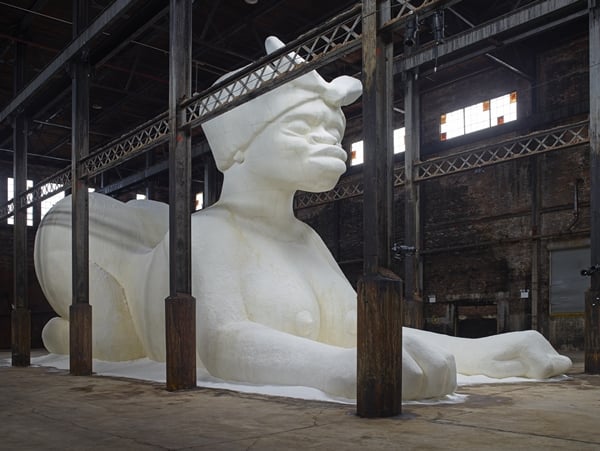People
‘Sugar Baby’ Lives On and 6 More Facts From Kara Walker’s New York Mag Profile
Where will the Sugar Sphinx pop up next?

Where will the Sugar Sphinx pop up next?

Brian Boucher

How does an artist survive the glaring spotlight of a work that stirs a national sensation and not be defined by it? If anyone promises to have the sangfroid to do so, it may be Kara Walker, whose first public art project Sugar Baby (2014), a giant sculpture of a mammy-cum-sphinx, was a smash hit in New York in 2014.
Hitting newsstands today is this week’s New York Magazine with a profile of the artist by Doreen St. Félix, in which Walker discusses Sugar Baby, reveals the ongoing life of that project, and divulges an unexpected early inspiration.
What is Walker working on now?
Following the smashing success of Sugar Baby, she’s planning more works in the public sphere. And Sugar Baby will be part of it.
“After A Subtlety, everybody was asking me to do something in a grist mill or some industrial setting,” she tells St. Félix. And so she will do. An erstwhile slaughterhouse on the Greek island of Hydra, belonging to famed collector Dakis Joannou’s deste Foundation for Contemporary Art, will host the left hand of the Sugar Baby (the one making the mildly obscene figa gesture) starting June 20. As Walker points out, the timing allows art world pilgrims to hit the Basel art fair, then the Venice Biennale, and then the deste exhibition.
And what else?
For her contribution to New Orleans’s Prospect.4 biennial, Walker is creating an original musical instrument with the help of an engineer, and, aided by a composer, she will use it to play protest songs to memorialize not only the black men killed by white vigilantes in the aftermath of Hurricane Katrina but also the slaves sold in the city in the 18th century.

Kara Walker, A Subtlety (2014). Photo Jason Wyche, courtesy Creative Time.
And what else?
A drawing St. Félix spies in the studio turns the tables between the races, showing, she writes, “a naked black woman whipping a police officer dressed in riot gear.”
A booming real estate market takes its toll
Manhattan rents for studio spaces are too expensive even for the likes of Walker; she’ll quit the Garment District in May and set up shop in the Industry City development in Sunset Park, Brooklyn.
See Walker put herself on the analyst’s couch
Walker’s father, Larry Walker, is also an artist. Even though he supports his daughter’s work, after viewing a lynching-themed piece of hers, he asked, “When are you going to get over this race thing?”
Walker jokingly offered up this analysis: “Perhaps you could say that much of my work is an endeavor to disappoint my father.”
A love interest, revealed
If you’re wondering about the extensive gallery of portraits shot for the profile by Ari Marcopoulos, or what his photos are doing over the walls at her pad, or what he’s doing in her home, putting records on the turntable, it’s because they’re an item. He’s also collaborated with her on print projects and exhibitions.
“I’m sure people already figured it out, but if they didn’t know yet, they’ll know now,” says Walker.
An unlikely inspiration
Perhaps surprising for an artist who would go on to treat deeply troubling subjects, when Walker started out at the Atlanta College of Art in 1987, she prized a letter and a cartoon that “Peanuts” artist Charles Schulz had sent her.